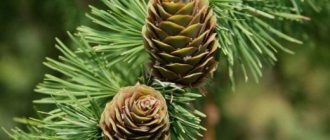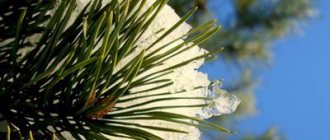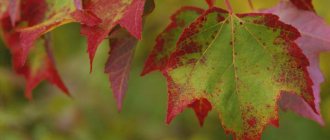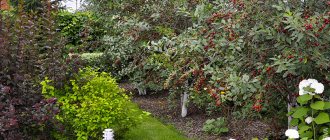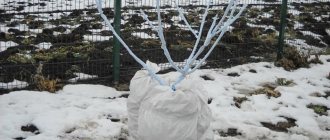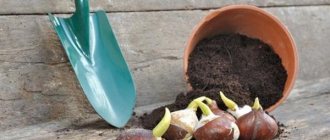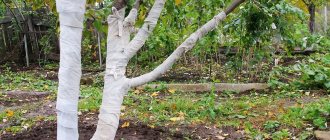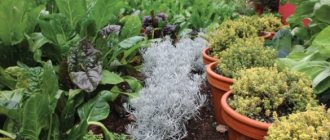What tree sheds its needles for the winter except larch, deciduous conifers
Contrary to popular belief, not all conifers are evergreens. Some of them are deciduous and the most common representative is larch.
Coniferous trees, features of their wintering
When caring for coniferous trees, it is important to remember that young specimens are sensitive to temperature fluctuations. This is due to the fact that the plant's roots are located too close to the surface.
That is why, when caring, it is recommended to mulch the root areas without fail. It is recommended to do this only until the plant gets stronger.
During wintering, the needles do not fall off, providing the plant with water and protecting it from the cold. The wax coating of the needles helps the trees protect themselves from hypothermia and unnecessary water loss. Thus, wax is a kind of protective film.
An adult tree retains its bright green color even with the onset of frost, when the root areas are covered with a layer of ice. During this period, additional care comes down to cutting off excess branches.
Which tree sheds its needles for the winter?
Although conifers are considered evergreen, the effect is achieved by gradually changing needles - old ones fall off, new ones grow in their place, and this happens not during a specific season, but throughout the year. However, several representatives of coniferous plants behave in a similar way to deciduous plants, shedding their leaves-needles in the fall.
Larches also tend to completely change their green cover every year, shedding needles in the fall and acquiring new ones every spring. The new needles are very tender and soft, despite the fact that the wood of the tree is extremely hard.
Larch is a tree that sheds its green clothes every autumn. Despite the fact that the needles of this plant are very soft, the wood is considered one of the strongest in the world.
Like deciduous representatives, larch needles begin to turn yellow and fall off completely by autumn. By spring, the branches are again overgrown with green needles as growth intensifies.
This property developed in the plant as a result of the plant's adaptation to cold climates. In this way, larch minimizes energy waste in winter.
In addition to larch, there are several other types of plants that shed their leaves when it gets cold. However, this tree is the most common and famous.
When larch sheds its needles, wintering characteristics of the plant
Larch, which is one of the few conifers that sheds its needles during the winter, lives on average 350 to 400 years. Some species can live up to 500 years.
Unlike other conifers, larch needles are not hard and sharp. Soft to the touch, easy to break, outwardly they resemble ordinary thin and flat leaves.
The wintering features of the plant include:
- Shedding of leaves begins at the end of September. This feature allows the species to spread further north than other large trees;
- Dropping needles for the winter helps the plant protect itself from drying out, which threatens many conifers when the soil freezes;
- During the winter, the tree goes into a kind of hibernation; all processes in it slow down and return to normal only in spring.
Wintering features help the plant survive the harshest cold. If coniferous trees can die as a result of excessive evaporation of water through the needles, then larch tolerates cold weather without much harm to itself.
Is the only coniferous tree that sheds its needles for the winter, others are deciduous?
Despite the fact that larch is considered the most famous and widespread tree that sheds its needles for the winter, there are several other types of deciduous conifers.
Metasequoia
The first is Metasequoia, which is a coniferous plant; it belongs to the cypress family.
Features of this plant include:
- The bulk of representatives are distributed in the Hubei province area;
- The average height of the tree is 35-40 m, cut diameter is 2 m;
- The branches are located oppositely, forming a wide-conical crown;
- Can reach an age of more than 600 years;
- Distributed on mountain slopes, along river beds and the edges of hollows, where it forms mixed forests;
- It is distinguished by its ease of reproduction and growth rate. Thanks to the latter, it develops quickly, both when propagated by cuttings and seeds;
- It is unpretentious to soil conditions and temperature fluctuations, although it thrives best in humid subtropical countries.
This relict genus contains several species. Matasequoia cones are hanging with shield-like woody scales.
Swamp Cypress
Another representative of deciduous conifers is Taxodium birow or swamp cypress.
Characteristic features of these large trees include:
- Widely distributed in marsh regions of the United States from Texas and Florida to Delaware;
- It reaches a height of 35-45 m;
- Narrow and long leaves are arranged in several opposite rows and reach 1.3-1.9 cm in length.
An interesting feature of Taxodium is the fact that regular excessive watering provokes expansion of the lower part of the trunk. As a consequence, the development of pneumatophores, outgrowths that rise above the soil and water.
Widespread in swampy areas for additional anchorage to the soil.
Shedding needles in winter is a characteristic feature of some genera. One of the most common representatives of this group is larch.
Dropping the needles helps the larch to endure the cold snap of winter as painlessly as possible.
For more detailed information about larch and its cultivation, watch the video:
Source: https://OgorodSadovod.com/entry/3560-kakoe-derevo-sbrasyvaet-khvoyu-na-zimu-krome-listvennitsy-listopadnye-khvoinye
Coniferous trees, features of their wintering
When caring for coniferous trees, it is important to remember that young specimens are sensitive to temperature fluctuations. This is due to the fact that the plant's roots are located too close to the surface.
That is why, when caring, it is recommended to mulch the root areas without fail. It is recommended to do this only until the plant gets stronger.
During wintering, the needles do not fall off, providing the plant with water and protecting it from the cold. The wax coating of the needles helps the trees protect themselves from hypothermia and unnecessary water loss. Thus, wax is a kind of protective film.
An adult tree retains its bright green color even with the onset of frost, when the root areas are covered with a layer of ice. During this period, additional care comes down to cutting off excess branches.
What properties of larch do only specialists know about?
Coniferous trees are characterized by a periodic change of needles. This is a gradual renewal of trees, which occurs not in a specific season, but throughout the year. Coniferous trees that shed needles include:
Larch
Deciduous coniferous tree, which is common in Western and Central Europe. It grows in the Alps and Carpathians, located at altitudes from 1000 to 2500 meters above sea level. Its height reaches 50 meters, and its trunk diameter is 1 meter.
But dozens of decorative forms have been developed, including dwarf ones, that will decorate the garden without taking up much space. It is planted in public places in several groups, on alleys or in courtyards. Unlike other representatives, the needles are not sharp, soft and easily break when pressed.
At the same time, the wood of this coniferous tree is one of the strongest in the world.
It is characterized by the following properties:
- frost-resistant;
- unpretentious to the soil;
- adapts well to urban conditions.
Larch is a coniferous tree that sheds its needles for the winter. This feature appeared as a result of its adaptation to harsh climates and low temperatures. Thus, she spends a minimal amount of energy in the winter cold.
Matesequoia
This is a deciduous coniferous tree up to 40 m high with a trunk diameter of 2.5 m. The crown is slender and cone-shaped. The barrel at the bottom has many indentations and looks very impressive.
The needles are 1-3 cm long and 2 mm wide at first bright green, then darken in summer, and before falling in autumn they become pale yellow or light pink to ruby red and reddish brown, depending on location and weather conditions. The needles are unusually soft.
They grow late - by the end of May, and fall in early November. Metasequoia is shade-tolerant, but develops better in open areas.
It grows quickly, is heat-resistant and frost-resistant down to -30°, wind-resistant, is not demanding on soils, but prefers well-drained, fertile and moist ones, and is stable in urban conditions. In China, it grows successfully on the streets and even along the sides of highways. Looks good near bodies of water.
Coniferous trees with needles falling off in winter
With the word “coniferous” we associate the idea of trees that always remain green, like spruce or pine. Indeed, almost all conifers are evergreen. However, there are exceptions to this rule.
What conifers shed their needles for the winter? Ask this question to a person who is not very experienced in botany, and you will get the answer: “larch.” This is correct, but only partly. Indeed, larch turns yellow in the fall, and then completely sheds its soft needles, i.e.
behaves similarly to our northern deciduous trees (hence its name).
But is this the only tree that sheds its needles for the winter? Are there other conifers that behave in a similar way? A person unfamiliar with botany will not answer these questions. Meanwhile, among conifers there are deciduous trees besides larch. Some of them can be seen in the Batumi Botanical Garden.
Here is the first one. In winter, it is very similar in appearance to larch. However, an attentive eye will notice that there is not a single cone on the tree. There are a lot of rhombic, slightly thickened woody plates lying under the tree.
Here you can also find winged seeds, reminiscent of pine and spruce seeds, only slightly larger. It is easy to guess that the rhombic plates are nothing more than scales of cones that have fallen from the tree. Consequently, the cones crumble when ripe, just like real cedar.
And if so, then it is not larch (its cones never fall apart and hang “intact” on the branches for a long time). Before us is a completely different plant - Kaempfer's false larch (Pseudolarix kaempferi). Its natural distribution area is the mountains of Eastern China.
There it grows in coniferous forests at an altitude of 900-1200 m above sea level. In culture, false larch is valued as an ornamental tree because of its beautiful needles.
The second deciduous coniferous tree is Taxodium distichum. Its homeland is North America. The tree is named swamp cypress because it often grows in swamps.
It is also not called cypress by chance: its spherical cones resemble the cones of a real cypress. But if the cones of an ordinary cypress are very strong and difficult to break with your hand, then those of a swamp cypress are completely different.
As soon as you pick up a mature cone from the ground and squeeze it a little in your hand, it crumbles into pieces.
Swamp cypress has the rare ability to develop special respiratory roots, the so-called pneumatophores. Unlike ordinary roots, they grow upward, rising above the ground.
Their appearance is very peculiar - thick, woody shoots of a bizarre shape, resembling either skittles or some kind of knotty bottles. Breathing roots consist of very light, porous wood, although quite strong; there is a channel inside.
They are vital for the plant. Through these shoots, air penetrates to the root system of the tree, hidden in the swamp soil. And the soil of swamps is very unfavorable for plant life due to excess water and lack of oxygen.
Without special pneumatophores, the tree could have died. Breathing roots grow from thick horizontal roots spreading from the trunk in different directions.
Thanks to its breathing roots, swamp cypress can grow in areas that are covered with water for weeks or even months. Under these conditions, vertical roots grow to such a height that they are above the surface of the water. Their maximum height reaches 3 m.
In the Batumi Botanical Garden, well-defined respiratory roots can be seen in one of the large swamp cypress trees growing in a very damp place (Fig. 20). Other specimens located in drier areas do not form such roots.
The swamp cypress exhibits the phenomenon of branch fall, which is already familiar to us - in the fall, entire branches fall off along with the needles. True, this does not happen with all branches. Some of them remain on the tree, only needles fall off.
The geographical distribution of swamp cypress is interesting. It currently grows wild only in southeastern North America.
But before it was widespread across the globe, including in Europe, where fossil remains of this plant are often found.
Swamp cypress is one of North America's most valuable timber trees and is heavily harvested. Its wood is an excellent building and ornamental material; it remains in the soil for a long time.
The foliage of the swamp cypress is beautiful, light green, lacy. This tree is often cultivated for decorative purposes on highly moist soils, along the banks of reservoirs, where other tree species cannot grow.
The third deciduous conifer is the famous metasequoia (Metasequoia glyptostroboides). This tree is in the truest sense of the word “living fossil”: it is as if “resurrected from the dead.” It was found only in fossil form and was considered completely extinct. And suddenly on the 8th of 1941-1942.
In one of the regions of China, scientists accidentally discovered a living, rather old metasequoia tree. And a little later, in 1944, a whole grove was found. It turned out that the plant was not extinct at all. This discovery created a real sensation in the botanical world.
Zoologists also have similar cases when they find animals that were considered to have long disappeared from the face of the Earth (for example, the coelacanth fish).
It is clear that in the Batumi Botanical Garden, as in other gardens, you can only see young specimens of metasequoia, they are no more than 20-30 years old.
What is metasequoia? This is a slender tree with a straight trunk and a cone-shaped crown, which starts almost from the ground. In summer the tree is very decorative - the crown has a beautiful soft green color. The needles are soft, and individual needles are almost the same as those of a swamp cypress.
In winter, metasequoia does not attract attention to itself - only bare branches. If you look at it from a distance, you won’t even think that it’s a coniferous tree. And even up close you won’t recognize it right away. True, if you look at the ground, you can see that under the tree there are not leaves, but reddish dry needles.
More precisely, whole branches with pine needles. Metasequoia, like swamp cypress, is a branching tree. In winter, when there are no needles on the trees, the branches of both plants are quite similar.
However, in metasequoia, thin young branches are located differently than in swamp cypress: they extend from thicker branches in pairs, one against the other.
In winter, you can recognize a coniferous tree in a metasequoia by the cones that can be seen here and there among the branches. True, they are small and not very noticeable. Outwardly, they resemble evergreen sequoia cones.
This similarity should not be surprising: both trees are quite close relatives. As we already know, one of them grows in North America, and the other in Southeast Asia.
Again a familiar phenomenon - close relatives on different continents.
Well-known and common representatives include the following.
Marsh (Taxodium biserialis)
The plant is native to North America. It is distinguished by strong wood and the presence of respiratory roots (pneumatophores). The development of the latter is determined by the natural distribution area of the species.
Found in swamp areas of the USA (from Texas to Delaware). Since swamp soil is characterized by a large amount of moisture and a lack of air, respiratory roots provide the plant with an additional source of oxygen. By autumn, not only leaves fall, but also twigs.
False Kaempfmer
Outwardly very similar to Siberian Larch, it is easy for an inexperienced gardener to make a mistake. The differences are that this species does not have cones that crumble into diamond-shaped plates when ripe, like those of.
The distribution area of the plant is the mountains of Eastern China, where the plant forms forests. It became widespread in gardening culture due to the unique beauty of its needles.
Source: https://KomnatnieCveti.ru/frukty/listvennica-osenyu-zhelteet-i-opadaet.html
Why does larch shed its needles?
The reason for shedding needles is to protect oneself in winter. It grows in harsh conditions where other trees no longer grow. By shedding the needles, it gets rid of excess moisture, because the root system does not absorb moisture from the frozen soil. Thus, shedding needles helps to painlessly survive severe frosts in winter.
Features of wintering larch:
- shedding of needles begins at the end of September, which allows relatives to live to the north;
- with the help of shedding, it protects itself from drying out, which is typical of coniferous trees when the soil freezes in winter;
- In winter it goes into a kind of hibernation, development slows down and resumes only in the spring.
European larch
European larch is distributed throughout Europe. Not demanding on soils. Frost-resistant, resistant to urban conditions. This larch is durable, living up to 500 years or more. The peculiarity of larch is that it is a deciduous tree, that is, the leaves fall off in the winter, and in the spring new green needles appear. European larch is a very large plant. Individual specimens reach a height of more than 50 m and a width of up to 15 meters; the crown shape is regular, cone-shaped. For such a tree you will need a lot of space on your site. European larch is planted in massifs, groups, alleys, and rows. Despite the fact that European larch is a fast-growing tree, many people want to immediately plant a ready-made tall tree. This is not a problem; in the garden center, large larches are dug up with a lump of earth and packed in burlap and netting (if necessary). Special equipment is used to transplant and deliver such a plant. If the size of the plot is small, then the growth of the tree can be restrained by regular pruning or you can choose compact varieties. Larch trees with a weeping crown shape are very beautiful.
Which coniferous plant sheds its needles for the winter?
A coniferous tree sheds its needles in the winter to protect itself from winter frosts and retain moisture. With the word “coniferous” comes an association with plants that remain evergreen, such as Christmas trees. However, botany experts will not agree with this statement.
Coniferous tree that sheds needles
Coniferous trees are characterized by a periodic change of needles. This is a gradual renewal of trees, which occurs not in a specific season, but throughout the year. Coniferous trees that shed needles include:
Which trees shed their leaves for the winter?
Leaf fall is a natural part of the development of most plants. This is how nature intended it, because in a naked state, the surface area for moisture evaporation is reduced, the risk of branches breaking, etc. is reduced.
Important!
Leaf fall is a vital process, without which the plant may simply die.
Different types of trees shed leaves differently. But the following crops shed their leaves every year:
- poplar (begins to shed leaves at the end of September);
- Linden;
- bird cherry;
- birch;
- oak (leaf fall begins in early September);
- rowan (loses leaves in October);
- apple tree (one of the last fruit crops to shed its leaves - in early October);
- nut;
- maple (can stand with leaves until frost);
Only coniferous plants remain green throughout the winter.
With a short summer, living conditions for the regeneration of leaves every year are extremely unfavorable. That is why there are more evergreen species in the northern regions. Did you know?
In fact, coniferous plants also shed needles. Only they do this not annually, but once every 2-4 years, gradually.
Which coniferous tree sheds its needles for the winter?
A coniferous tree sheds its needles in the winter to protect itself from winter frosts and retain moisture. With the word “coniferous” comes an association with plants that remain evergreen, such as Christmas trees. However, botany experts will not agree with this statement.
Why coniferous trees don't freeze in winter
Every tree absorbs carbon dioxide and produces oxygen. This process is called photosynthesis, which requires bright sunlight and plenty of water. In winter, this can be a problem, because daylight hours become shorter, and moisture is provided only by covered snow.
Important! To solve this problem, some coniferous trees shed their needles to evaporate the bulk of the moisture and go into hibernation until favorable conditions occur.
To retain moisture during the cold season, coniferous trees shed their needles for the winter. This process allows you to survive the harsh cold and renew the needles. These trees include larch, taxodium and metasequoia.
Source: https://fermilon.ru/sad-i-ogorod/derevo/kakie-hvoynye-derevya-sbrasyvayut-hvoyu-na-zimu.html
Why does larch shed its needles?
The main reason for shedding needles is to protect oneself in winter. It grows in harsh conditions where other trees no longer grow. By shedding the needles, it gets rid of excess moisture, because the root system does not absorb moisture from the frozen soil. Thus, shedding needles helps to painlessly survive severe frosts in winter.
Features of wintering larch:
- shedding of needles begins at the end of September, which allows relatives to live to the north;
- with the help of shedding, it protects itself from drying out, which is typical of coniferous trees when the soil freezes in winter;
- In winter it goes into a kind of hibernation, development slows down and resumes only in the spring.
A coniferous tree that sheds its needles for the winter?
With the onset of winter, the entire plant world freezes. Deciduous trees and shrubs shed their leaves and overwinter without them. Coniferous trees, on the contrary, overwinter without shedding their needles, with the exception of larch. Larch is the only coniferous tree that sheds its needles for the winter.
Coniferous trees are well adapted to winter. The needles are covered with wax and are very small, respectively, the area of evaporation, and in winter the area of freezing is very small. This helps retain moisture in winter.
Sheltering coniferous trees for the winter, all the pros and cons
Due to the fact that almost all coniferous trees are well adapted to Russian winters and to the weather conditions of the middle zone, as a rule, there are no problems with wintering. The exceptions are yew berry and cypress. These plants overwinter very poorly without shelter, and besides, they suffer more than other conifers from the spring sun.
There are two opinions about how and when to cover all conifers, and whether it should be done at all. Some experts argue that all coniferous trees must be covered for the winter, or must be protected from the spring sun in early March.
Some do not recommend covering at all, citing the fact that conifers are perfectly adapted to our winters, and therefore do not freeze or suffer from the spring sun. No one covers or protects trees growing in the forest from the spring sun.
In fact, everything is very individual. For example, conifers such as cypress and yew species, of course, can die without shelter, because The homeland of these plants is the southern regions, where there are no such severe winters as in the middle zone and northern regions. Again, in the southern regions the soil does not freeze in winter. Therefore, in their homeland, the spring sun cannot harm them, because
When the sun's rays first appear in spring, the plant can take moisture from the soil. In the middle zone and northern regions in early spring, when there is still snow and the frozen ground has not thawed, at the first rays of the sun, plants begin to come to life and wake up from hibernation, and the roots have nowhere to get moisture, because... the ground has not thawed yet. This is how “sunburn” occurs on coniferous plants.
Therefore, plants native to the southern regions must be covered for the winter to prevent freezing and spring loss of moisture. This should be done in late autumn, at the end of November.
Spruce Glauka goboza on a trunk
I think there is no need to cover coniferous plants that are adapted for the middle zone. They all cope well with the winter cold.
As a rule, thujas suffer in the spring, and then with rare exceptions. Young seedlings planted in the fall whose root system is not sufficiently developed need to be covered, and I recommend doing this in the fall, at the end of November.
Plants planted in spring need to be covered in March, when the spring sun begins to shine.
Mature plants, whose root system is well developed and goes deep into the ground, usually do not suffer in the spring.
Other types of conifers, such as spruce, juniper and pine, should not be covered at all. It is enough to insulate the tree trunk circle in the fall, for example, with fallen leaves or straw. Such a shelter will protect the root system and retain moisture in the root zone. Mown lawn grass can serve as a good cover for the root system. This will serve as excellent fertilizer and insulation.
Coniferous trees, with the exception of those that need it, tolerate winter shelter very poorly. They stand tightly twisted and wrapped in covering material for too long.
Conifers sheltered for the winter take a very long time to come to their senses, compared to those plants that were not sheltered. The needles of covered plants straighten out only by mid-summer.
It takes a long time to pour out the root system and arrange shower watering for the needles.
If you still decide to cover the plant for the winter, then for this you need to make a frame in the form of a wigwam, and cover the top with a covering, breathable material, such as spunbond.
Yew Berry
Why do needles fall off trees?
Pine needle rust - the pathogen penetrates through the stomata.
We often hear complaints from the owners of their garden plots that something wrong is happening to their favorite spruce, pine, fir or larch: the needles have turned yellow and are falling off, the bark is peeling, strange thickenings and growths have appeared. Often these signs indicate tree disease. It is very likely that pathogenic fungi were the culprits of the trouble.
